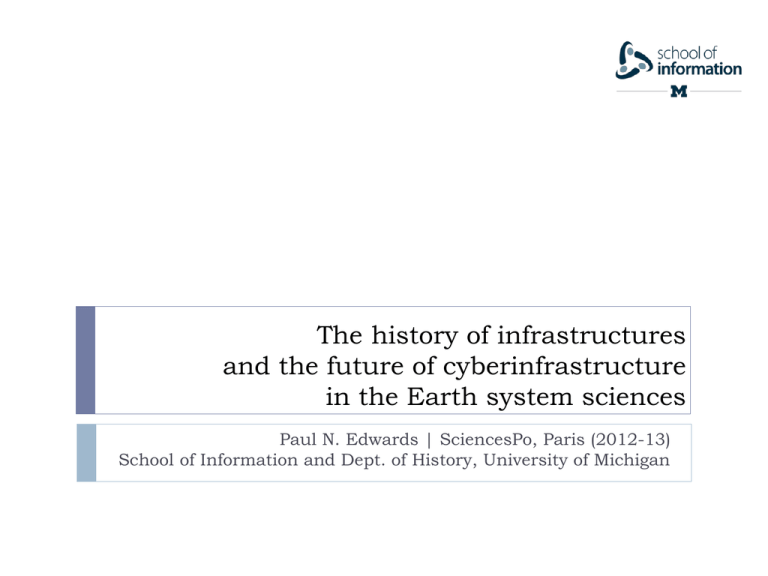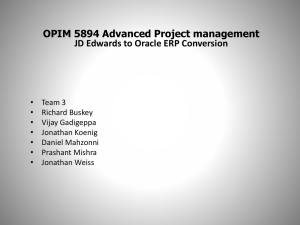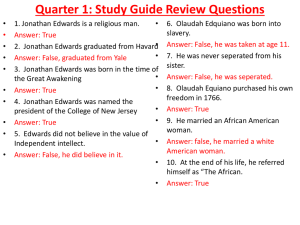The History of Infrastructure and the Future of
advertisement

The history of infrastructures and the future of cyberinfrastructure in the Earth system sciences Paul N. Edwards | SciencesPo, Paris (2012-13) School of Information and Dept. of History, University of Michigan “The Meteorological Society …wishes to be the central point, the moving power, of a vast machine, and it feels that unless it can be this, it must be powerless; if it cannot do all it can do nothing. It desires to have at its command, at stated periods, perfect systems of methodical and simultaneous observations; it wishes its influence and its power to be omnipresent over the globe so that it may be able to know, at any given instant, the state of the atmosphere on every point on its surface…” — John Ruskin, 1839 Paul N. Edwards Outline A historical model of infrastructure development Applying the model: The world weather forecast network Climate data Climate modeling Some lessons from history for future infrastructure development Paul N. Edwards Infrastructure: a historical model System building (Hughes 1983) System variations proliferate Networks time Dedicated gateways link heterogeneous systems Internetworks Designed, coherent, centrally organized Generic gateways link heterogeneous networks Decentralization, fragmentation, service tiering Edwards et al. 2007 Paul N. Edwards Dedicated or “improvised” gateways Connecting devices to different national power grids Whose responsibility? Who pays? Who sets standards? Paul N. Edwards Computer networks link computers Paul N. Edwards A generic gateway • • Global ISO standard Links road, rail, and shipping Paul N. Edwards Internetworks link networks Routers are gateways connect computers to each other (network) … and connect the local network to other networks “The” Internet connects millions of networks Protocols and standards permit this to work Paul N. Edwards Infrastructures are networks or internetworks (not systems) (Edwards et al. 2007) Systems Infrastructures Networks Elements Gateways and standards Boundaries Examples Internetworks or Webs Components, subsystems Heterogeneous systems Heterogeneous networks Dedicated or improvised Dedicated or generic Generic Closed, stable Closed or open, reconfigurable Open, reconfigurable State electric company National electric grid International electric grid Mainframe computer Network of similar personal computers Internet, World Wide Web Telegraph-based synoptic weather mapping National weather services (some elements) World Weather Watch Réseau Mondial GEOSS (Global Earth Observing System of Systems) Paul N. Edwards Applying the historical model Weather forecasting Systems National weather services Marine weather records Semi-standardized reporting forms (1850s forward) Networks Telegraph-based synoptic weather mapping Early regional telegraph networks (from 1850s) Internetworks Both within and across national networks, integrating: Surface stations Air bases and airports Marine data Satellites (NASA, EUMETSAT, etc.) Paul N. Edwards 1872 War Dept. synoptic map Paul N. Edwards Surface station coverage: evolution 1870 1900 1930 1960 Source: J. Hansen and S. Lebedeff, “Global Trends of Measured Surface Air Temperature,” Journal of Geophysical Research 92, no. D11 (1987), 13,346-13,347. Circles drawn around each station is 1200 km, Paul N. Edwards International networks: gateway institutions International Meteorological Organization (1879-1947) Non-governmental Set common standards, but lacked power to enforce Established principle of free data sharing World Meteorological Organization (1947-present) Intergovernmental Encouraged network development Regional meteorological centers Paul N. Edwards Synoptic map of the northern hemisphere, 5 may 1914 Paul N. Edwards Gateways between weather data systems Many conversions Temperature (°F vs. °C), pressure (Pa vs. bar), etc. Reporting forms Telegraph codes Recording media Codes and communication networks Telegraph, paper, punch cards, paper tape, digital tape, magnetic disk, RAM Telegraph, telex, fax, shortwave radio, telephone…. Most required human intervention Today, computers have automated most of these conversions …but new formats and conflicting standards still require human intervention Paul N. Edwards More gateways… Between multiple institutions within a nation… NASA (satellites) National Weather Service Air Force observing systems worldwide And between mulitiple international data networks WMO regional meteorological centers managed their own communication networks European Centre for Medium Range Weather Forecasts European national weather services EUMETSAT Paul N. Edwards an internetwork World Weather Watch • Planned early 1960s • Operational 1968 • Modern form of the world’s oldest and best developed global digital data infrastructure Paul N. Edwards Applying the historical model Global climate data: systems and networks The Réseau Mondial “Worldwide network” Proposed 1905 Organized by British Met Office (1911-1950s) World Weather Records ~ 500 stations on a 10° lat-long grid, 80°N to 61°S Smithsonian Institution, 1927-1947 380 stations, including islands Later, became Monthly Climatic Data for the World Both efforts were central collectors Hampered by variations in standards Paul N. Edwards Different climate data systems, at different times… Source: Palutikof and Goddess, 1986 Paul N. Edwards Gateways in climate data analysis “Data guys”: historical knowledge used to clean and correct data Data analysis models Corrections for urban heating, instrument differences, etc. Weighting data to correctly represent surface area Reanalysis models Station sites, instrument changes, etc. Running historical weather data through a frozen weather analysis and forecast model Each of these combines heterogeneous national data sources to create homogeneous global data sets Paul N. Edwards Global climate data are produced by an internetwork (linked, heterogeneous data networks) IPCC 4th Assessment Report (2007), Fig. 1.3 Paul N. Edwards A climate data internetwork: observing systems used in ERA-40 climate reanalysis Paul N. Edwards Other gateways in climate science Model couplers connect models Model intercomparison projects Standard exercises and benchmarks AMIP (1988) CMIP (Coupled Model Intercomparison Project) — ongoing Data portals Model Coupling Toolkit (MCT) Earth System Modeling Framework Earth System Grid PCMDI (Program on Climate Model Diagnosis and Intercomparison) GO-ESSP (Global Organization of Earth System Science Portals) IPCC Connects multiple aspects of climate science Creates/maintains global community Connects science to policy Paul N. Edwards Some lessons from history Earth system sciences need global infrastructures Centralized design and control is not the primary path to working infrastructure Instead, build gateways (couplers) At least for data… Standards, technologies, institutions Must be lightweight, readily understood, easily transferred across regions and cultures Interoperability requires ongoing work Coupling with new tools, standards, institutions Maintaining capability amidst changing software ecosystems Paul N. Edwards Hierarchies and incentives international organizations (WMO, IPCC) Agencies (NASA, NOAA, NSF, DOE) consortium (UCAR) pays your salary university industrial or national lab decides on your tenure department (discipline) individual scientist Paul N. Edwards Hierarchies and incentives real-world problems natural sciences, social sciences disciplines (weather, climate) where your reputation matters most sub-disciplines (cloud physics) Paul N. Edwards Cyberinfrastructure pitfalls Software makes it seem easy to build gateways between systems and networks… … but social, institutional, and security gateways are even more important “You just…” Multiple institutional cultures Complex projects with many working groups Multiple security and legal standards can block interchange New kinds of work and workers at the interface of science and software Current career structures don’t have a good place for them Paul N. Edwards








